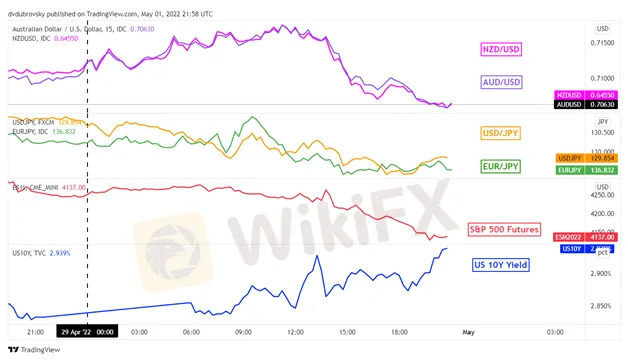简体中文
繁體中文
English
Pусский
日本語
ภาษาไทย
Tiếng Việt
Bahasa Indonesia
Español
हिन्दी
Filippiiniläinen
Français
Deutsch
Português
Türkçe
한국어
العربية
NASDAQ 100, JAPANESE YEN, FEDERAL RESERVE, CHINA PMI, CHINESE YUAN – ASIA PACIFIC MARKET OPEN
Abstract:FRIDAYS MARKET RECAP – NASDAQ 100, WORST MONTH SINCE 2008, US SPENDING, US DOLLAR, YEN
Nasdaq 100 sank on Friday, seeing worst month since the 2008 financial crisis
Anti-risk Japanese Yen received a break as traders flocked to its safety in droves
More turmoil to come before the Fed? Keep an eye on Caixin Chinese PMI data
Aggressive risk aversion plagued the last trading day of the week on Wall Street. On Friday, futures tracking the Nasdaq 100, Dow Jones and S&P 500 declined 4.48%, 2.8% and 3.64% respectively. In fact, April was the worst month for the Nasdaq 100 since October 2008, back when the global financial crisis wreaked havoc on financial markets. You would have been lucky to find a sector that didnt underperform.
So, what likely dented risk appetite? One could point to another round of solid US inflation-adjusted consumer spending data. Real personal spending rose 0.2% in March versus -0.1% anticipated. This was primarily boosted by services, rather than merchandise purchases, a sign of reversion back to pre-pandemic trends. Treasury yields surged across maturity spectrums, underscoring hawkish Fed bets.
In fact, the odds of a 75-basis point rate hike from the central bank in June climbed. On the chart below, you can clearly see the impact on markets. The US Dollar gained against the sentiment-linked Australian and New Zealand Dollars. This is as the anti-risk Japanese Yen capitalized on worrisome investors, finally catching a break from persistent destruction, recently amplified by a still-dovish Bank of Japan.
KEY MARKET PERFORMANCE LAST FRIDAY – WALL STREET MELTDOWN

NASDAQ 100 TECHNICAL ANALYSIS
Where does this leave the Nasdaq 100? On the 4-hour chart below, the index seemed to reinforce the 12801 – 12942 support zone. A breakout under this range exposes lows from March 2021. Still, positive RSI divergence does show that downside momentum is fading. That can hint at a turning point to come. Above, keep a close eye on the 50- and 100-period Simple Moving Averages for resistance.
NASDAQ 100 4-HOUR CHART

MONDAYS ASIA PACIFIC TRADING SESSION – RISK AVERSION TO CONTINUE? WATCH THE YEN AND YUAN
At the Asia-Pacific market open, the anti-risk Japanese Yen weakened as S&P 500 futures turned higher. This could perhaps be a sign of bears taking profit. Still, the proximity of the Federal Reserve rate decision could make it difficult for markets to fund sustainable upside momentum. As such, perhaps this may offer the Japanese currency some breathing space in the interim.
Over the weekend, China released April PMI data. Manufacturing figures clocked in at 47.4 against the 47.3 estimate. Readings below 50 indicate shrinking activity. While that was better than expected, non-manufacturing shrank to 41.9 against the 46.0 estimate. This is a clear sign of the governments Covid-zero policy denting economic activity, which has been increasingly associated with a weaker Yuan. Private surveys of equivalent Chinese activity will cross the wires later in the session.
USD/JPY TECHNICAL ANALYSIS
On the daily chart, USD/JPY was unable to hold a push above the 78.6% Fibonacci extension at 130.42 this past Friday. It stands as key immediate resistance. Negative RSI divergence does show that upside momentum is fading. This can precede a turn lower, placing the focus on the rising trendline from March. Closing under the trendline may open the door to a meaningful turn lower. Otherwise, clearing resistance will bring USD/JPY closer to the 2002 peak at 135.16.


Disclaimer:
The views in this article only represent the author's personal views, and do not constitute investment advice on this platform. This platform does not guarantee the accuracy, completeness and timeliness of the information in the article, and will not be liable for any loss caused by the use of or reliance on the information in the article.
Read more

BaFin Issues Warning Against Clone Broker Exploiting Pepperstone's Identity
The German Federal Financial Supervisory Authority (BaFin) has recently flagged a fraudulent clone of the licensed retail FX and CFD broker Pepperstone. This fake entity, operating under the domain pepperstone.life, has been offering financial and investment services without obtaining the necessary regulatory authorisation.

TikTok: A Rising Hub for Investment Scams in Malaysia
The Royal Malaysian Police (PDRM) have raised concerns over the increasing use of TikTok by criminal syndicates to lure victims into investment scams.

Webull Canada Expands Trading Hours with Options Trading
Webull Canada now offers extended trading hours from 4 a.m. to 5:30 p.m. ET, plus options trading. Gain flexibility and manage risk in an ever-changing market.

Webull and Others Fined $275,000 for Incomplete Suspicious Activity Reports
Webull Financial, alongside Lightspeed Financial Services Group and Paulson Investment Company, LLC, has agreed to pay a collective fine of $275,000 following an investigation by the US Securities and Exchange Commission (SEC). The penalty was issued due to the firms’ failure to include essential information in suspicious activity reports (SARs) over a four-year period.
WikiFX Broker
Latest News
Saxo & Portuguese Bank Partnership
SEC Fines Broker-Dealers $275K for Incomplete SAR Filings
Elon Musk Warns of Imminent US Bankruptcy | Bitcoin Retreats from $100K
WikiEXPO Global Expert Interview: Advanced Practices and Insights in Financial Regulation
Justin Sun Invests $30M in Trump-Backed World Liberty Financial
Kraken Closes NFT Marketplace Amid New Product Focus
Robinhood Launches Ethereum Staking with 100% Rewards Match
Lured by False Promises: Malaysian Driver Lost RM218K to an Investment Scam
FTX Sets March 2025 Timeline for Creditor Payouts: What It Means for Investors
What is an Economic Calendar? How it works
Currency Calculator



